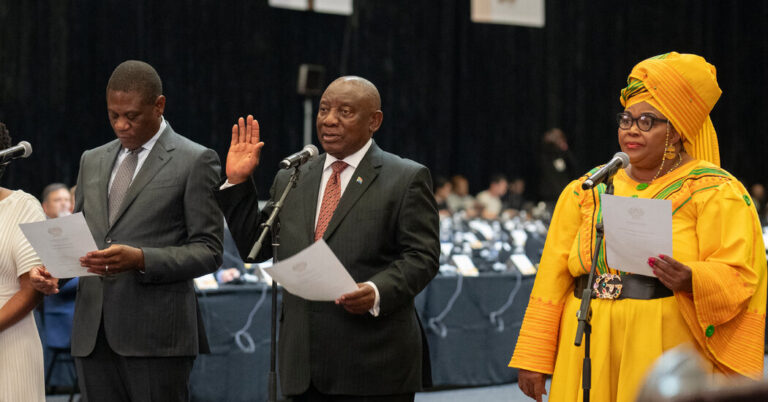After South Africa’s president announced the formation of the country’s largest democratic government in its history on Sunday, some critics questioned whether attempts to appease diverse political interests will complicate tackling the country’s myriad economic and social problems.
President Cyril Ramaphosa has promised for years to reduce the size of government, due to demands from the public and his political opponents, but his party, the African National Congress, failed to win an absolute majority in parliament in recent elections for the first time since the end of apartheid three decades ago, forcing him to appoint a broad coalition to his cabinet.
He increased the number of ministers from 30 to 32 and deputy ministers from 36 to 43. The total number of ministers and deputy ministers, 75, is more than any administration since the first democratic elections in 1994. Now lies the challenge of coordinating this diverse group of politicians to forge a coherent policy agenda for a country plagued by high unemployment, persistent poverty and shoddy delivery of basic services.
“So all parties have railed against the bloated cabinet only to end up choosing between a bloated executive or their members being denied posts,” Mosibudi Motimel, a political science lecturer at the University of the Free State in South Africa, wrote on social media.
“Again,” she added, “the politics here are about power and status and have nothing to do with people or policies.”
But President Ramaphosa and the leader of the second-largest party, the Democratic Alliance, insist the executive branch, formed in negotiations about a month after the May election, is working together to steer South Africa in the right direction.
“Although the ministers and deputy ministers who make up the national executive are drawn from different political parties, they are expected to serve the people as a whole,” Ramaphosa said in his weekly letter to the nation on Monday. “They are expected to deliver a common mandate and a common plan of action.”
Ramaphosa’s government was formed after two weeks of tense negotiations between his party, the ANC, and the Democratic Alliance, which at one point appeared to be on the verge of collapsing.
The election saw the ANC win 40 percent of the vote, while the Democratic Alliance won 22 percent. But the two parties clashed over how many ministerial posts the Democratic Alliance should get under a cooperation agreement the two parties signed in mid-June. The agreement led to the formation of the so-called Government of National Unity, which includes 11 of the 18 parties in parliament that are in the ANC-led coalition government.
The ANC has asked all parties in parliament to join a unity government, but former president Jacob Zuma’s third-largest party, Umkhonto weSizwe, has declined. With more than 14 percent of the vote, Zuma’s party will lead the opposition coalition.
In the end, the Democratic Alliance won six ministers and six deputy ministers. The third largest party in the coalition, the Inkatha Freedom Party, won two ministers, while the Patriotic Union, the Freedom Front Plus, the Azania Pan African Congress and the Good Party each won one minister.
“The Democratic Alliance has never run for this job for the sake of the title itself,” Democratic Alliance leader John Steenhausen said in a speech on Monday. The party “refused to accept a watered-down compromise to secure a post with real substance,” he added.
“Our mission is to painstakingly rebuild the government institutions currently under our control,” he said.
Steenhuisen was appointed minister of agriculture, a department that previously also had responsibility for land reform and rural development, but President Ramaphosa made land reform a separate department and appointed Pan African Congress leader Mzwanele Nyontoso as minister.
This creates an interesting dynamic because Njitso’s party has, in its manifesto, strongly promoted “land restoration” to black South Africans whose land was taken from them during colonization, while the Democratic Alliance has generally advocated for greater land ownership opportunities for South Africans, but not in terms of racial justice.
So-called land reform, which would increase land ownership among black South Africans, will require coordination between Steenhausen and Njihontso’s ministries. Once land is transferred, the new owners often need financial support from the agriculture ministry to farm it efficiently.
“Without fast-tracking land reform, we may not be able to achieve additional agricultural growth and inclusiveness,” said South African agricultural economist Wandile Silhobo.
In an interview, Motimel, of the University of the Free State, said forming a cabinet was a big gamble, but the most crucial moment for the country was now in formulating and implementing policies.
“Now is the time for social movements, civil society and ordinary South Africans to get involved in shaping what happens,” she said.

